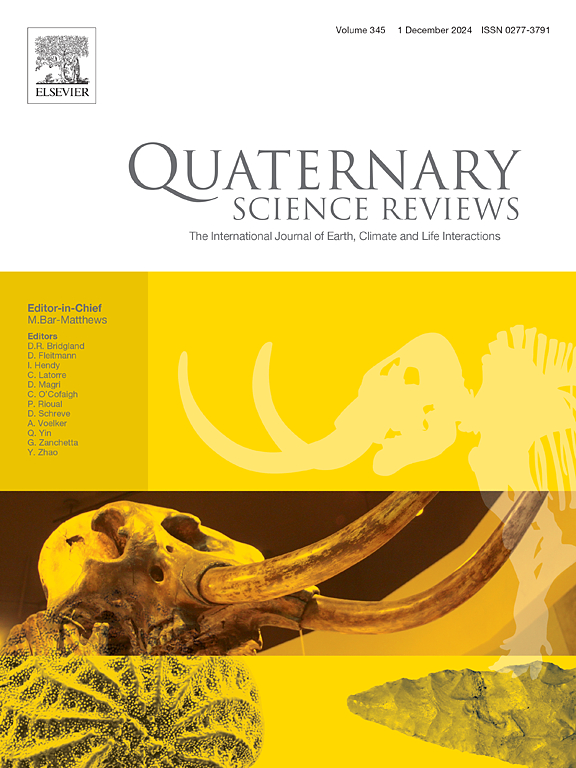Sediments in small endorheic basins as regional paleoenvironmental archives across a Mediterranean to arid transect
IF 3.3
1区 地球科学
Q1 GEOGRAPHY, PHYSICAL
引用次数: 0
Abstract
In areas where environmental settings are changing across relatively small distances, using a limited number of proxies for paleoenvironmental interpretations may obscure distinctive responses in each environmental niche and the regional effects of climate change. Here we demonstrate the application of sedimentological, geochemical, and luminescence-based proxies in three small endorheic basins, located along a sharp climatic gradient of 150 km in the southern Levant. This approach yields a regional paleoenvironmental framework corresponding to three major established depositional phases, while the local response during each of these phases differs between sites. The earliest phase, coinciding with MIS 3 (∼57-29 ka), is marked by humid conditions leading to weathering and soil formation towards the paleoshore and loess washdown into a shallow waterbody at the southern, currently arid, edge of the studied transect. The uncomfortably overlaying deposits (∼20-6.5 ka) capture a phase of environmental instability, with fluctuating sea levels, southwesterly aeolian sand influx, and the establishment of a coastal wetland environment. The last stage began around 6.5 ka, with continuous accumulation in localized coastal paludal environments and the stabilization of Mediterranean atmospheric circulation. This stability was interrupted by distinct second-order variations in sedimentation resulting from short-term climatic perturbations. Larger environmental instability is seen at the southern tip of the transect during the middle to late Holocene. This spatial difference is attributed to decreasing Mediterranean-derived humidity coupled with the influence of southerly atmospheric systems, resulting in event-based deposition of recycled sediment.
These records can provide a regional framework to study how distinct environmental settings capture variations in environmental forcing through allochthonous and autochthonous processes. Such settings include the distance to sediment sources, location along atmospheric trajectories, and the geographical context. The decoupling of site-related effects from the compiled regional trend allows tracking the responses to established climatic trends, underscoring the importance of studying spatially spread and relatively temporally continuous archives.
内陆小盆地沉积物作为地中海到干旱样带的区域古环境档案
在环境背景在相对较小距离内发生变化的地区,使用有限数量的代用物进行古环境解释可能会模糊每个环境生态位的独特响应和气候变化的区域影响。在这里,我们展示了沉积学、地球化学和基于发光的代用指标在三个小内陆盆地的应用,这些盆地位于黎凡特南部150公里的陡峭气候梯度上。这种方法得到了一个区域古环境框架,对应于三个主要的沉积阶段,而每个阶段的局部响应在不同的地点是不同的。最早的阶段,与MIS 3 (~ 57-29 ka)相一致,以潮湿条件为标志,导致古海岸风化和土壤形成,黄土被冲入研究样带南部干旱边缘的浅水体。令人不安的上覆沉积物(~ 20-6.5 ka)捕获了一个环境不稳定的阶段,海平面波动,西南风沙流入,沿海湿地环境的建立。最后阶段开始于6.5 ka左右,局部沿海古带环境持续积累,地中海大气环流趋于稳定。这种稳定性被短期气候扰动引起的沉降的明显二阶变化所打断。在全新世中晚期,样带南端的环境不稳定性较大。这种空间差异归因于地中海来源的湿度减少,加上南部大气系统的影响,导致基于事件的再循环沉积物沉积。这些记录可以提供一个区域框架来研究不同的环境背景如何通过异地和本地过程捕捉环境强迫的变化。这些设置包括到沉积物源的距离、沿大气轨迹的位置和地理环境。将地点相关影响与汇编的区域趋势解耦,可以跟踪对既定气候趋势的响应,强调了研究空间传播和相对时间连续的档案的重要性。
本文章由计算机程序翻译,如有差异,请以英文原文为准。
求助全文
约1分钟内获得全文
求助全文
来源期刊

Quaternary Science Reviews
地学-地球科学综合
CiteScore
7.50
自引率
15.00%
发文量
388
审稿时长
3 months
期刊介绍:
Quaternary Science Reviews caters for all aspects of Quaternary science, and includes, for example, geology, geomorphology, geography, archaeology, soil science, palaeobotany, palaeontology, palaeoclimatology and the full range of applicable dating methods. The dividing line between what constitutes the review paper and one which contains new original data is not easy to establish, so QSR also publishes papers with new data especially if these perform a review function. All the Quaternary sciences are changing rapidly and subject to re-evaluation as the pace of discovery quickens; thus the diverse but comprehensive role of Quaternary Science Reviews keeps readers abreast of the wider issues relating to new developments in the field.
 求助内容:
求助内容: 应助结果提醒方式:
应助结果提醒方式:


